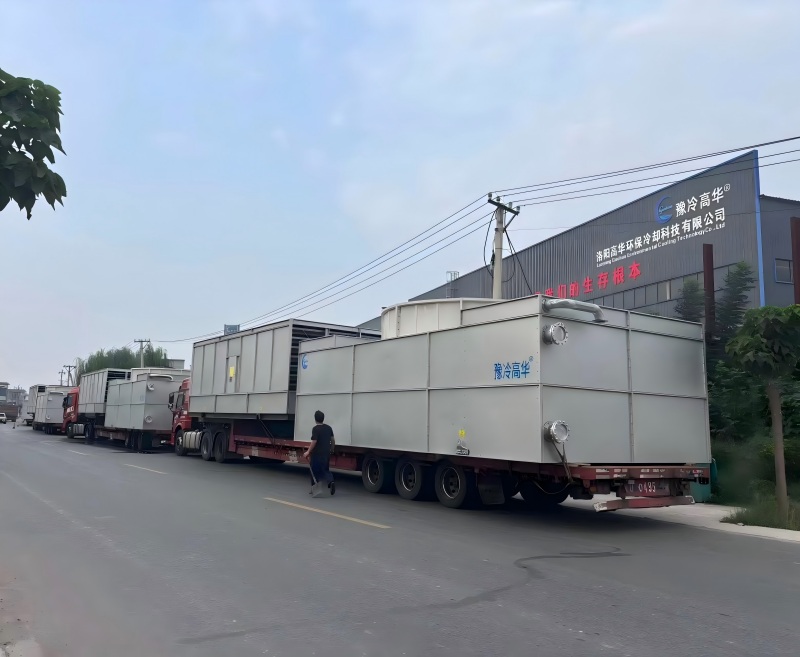An ammonia evaporative condenser is a highly efficient condensing unit that integrates a tube-and-coil heat exchanger, a water circulation system, and a fan system into a single package. Its core operating principle leverages water evaporation to cool and condense ammonia vapor circulating inside the coil.
Simply put, it acts like a custom-designed "smart air conditioner" for the ammonia refrigeration system, using the evaporation of water into air to remove massive amounts of heat with minimal energy consumption.
1. Core Components & Working Principle
A typical ammonia evaporative condenser consists of three main subsystems:
- Heat Exchanger Coil (The Core)
- Material: Must be constructed from seamless carbon steel tubes. This is because ammonia is corrosive to copper and other non-ferrous metals, while carbon steel offers superior resistance and mechanical strength.
- Design: Typically utilizes integrally extruded finned tubes or L-footed wrapped fin tubes to maximize the heat transfer surface area. The coil circuitry is designed to ensure even steam distribution and smooth condensate drainage.
2. Water Circulation System
- Spray System: A network of nozzles evenly distributes water over the external surface of the coil, forming a thin film.
- Recirculating Pump: Drives the water flow.
- Sump/Sump Tank: Located at the base of the unit, it collects the water.
3. Fan System
Typically employs axial fans to force a powerful airflow upward or horizontally through the wet coil section.
The working process can be broken down into three key steps:
Step 1: Hot, high-pressure ammonia vapor from the compressor enters the coil.
Step 2: Spray water forms a film on the outside of the coil, while the fans drive high-velocity air across it. A portion of this water evaporates, absorbing a vast amount of latent heat of vaporization (this accounts for ~70% of the heat rejection). The remaining, cooled water falls back into the sump.
Step 3: Inside the coil, the ammonia vapor releases heat, condenses into high-pressure liquid ammonia, and exits the unit to be recirculated in the system.
4. Key Technical Advantages
Compared to standalone water-cooled or air-cooled condensers, ammonia evaporative condensers offer significant benefits:
- Superior Energy Efficiency: By utilizing the latent heat of water evaporation, the condensing temperature can approach the ambient wet-bulb temperature, which is considerably lower than the dry-bulb temperature. This results in lower condensing pressure, reducing compressor work and leading to substantial energy savings, often exceeding 20%.
- Outstanding Water Conservation: Since the primary heat rejection mechanism is evaporation, water consumption is only 5%-10% of that required by a conventional cooling tower + shell-and-tube condenser system. This is crucial in water-scarce regions.
- Compact Footprint: It integrates heat exchange, water cooling, and air movement into a single unit, requiring far less space than a separate "cooling tower + condenser" setup.
- Reliable Operation & Low Maintenance: The system design is robust. Carbon steel coils offer excellent long-term resistance to ammonia corrosion. Its design also provides better freeze resistance than conventional cooling towers in cold weather.
5. Typical Applications
Ammonia evaporative condensers are the ideal solution for numerous industries, including:
- Food Processing & Cold Storage: Large freezing plants, food processing facilities.
- Chemical & Pharmaceutical: Process cooling, reactor temperature control.
- Beverage & Brewing: Fermentation tank cooling, cleanroom air conditioning.
- Logistics & Distribution Centers: Refrigeration systems for large-scale warehouses.
- Plastics & Rubber Industry: Cooling for production machinery.
6. Selection and Maintenance Considerations
Key Selection Criteria:
- Heat Load Calculation: Accurately determine the total system heat rejection requirement.
- Local Design Wet-Bulb Temperature: This is the critical climatic parameter for sizing the unit.
- Material Selection: Verify materials and corrosion protection (e.g., hot-dip galvanizing) for key components.
- Fan Control: Variable Frequency Drive (VFD) fans are highly recommended for automatic load adjustment, enabling further energy savings.
7. Maintenance Best Practices:
- Water Treatment: This is the most critical maintenance activity. Regular chemical treatment is crucial for preventing scale formation and biological growth, thereby ensuring unimpeded water flow and optimal heat transfer.
- Regular Cleaning: Keep the coil surface clean to prevent dust and debris from blocking airflow.
- Cold Weather Protection: In freezing climates, freeze protection measures (e.g., electric heat tracing) are necessary, and the sump should be drained during prolonged shutdowns.
